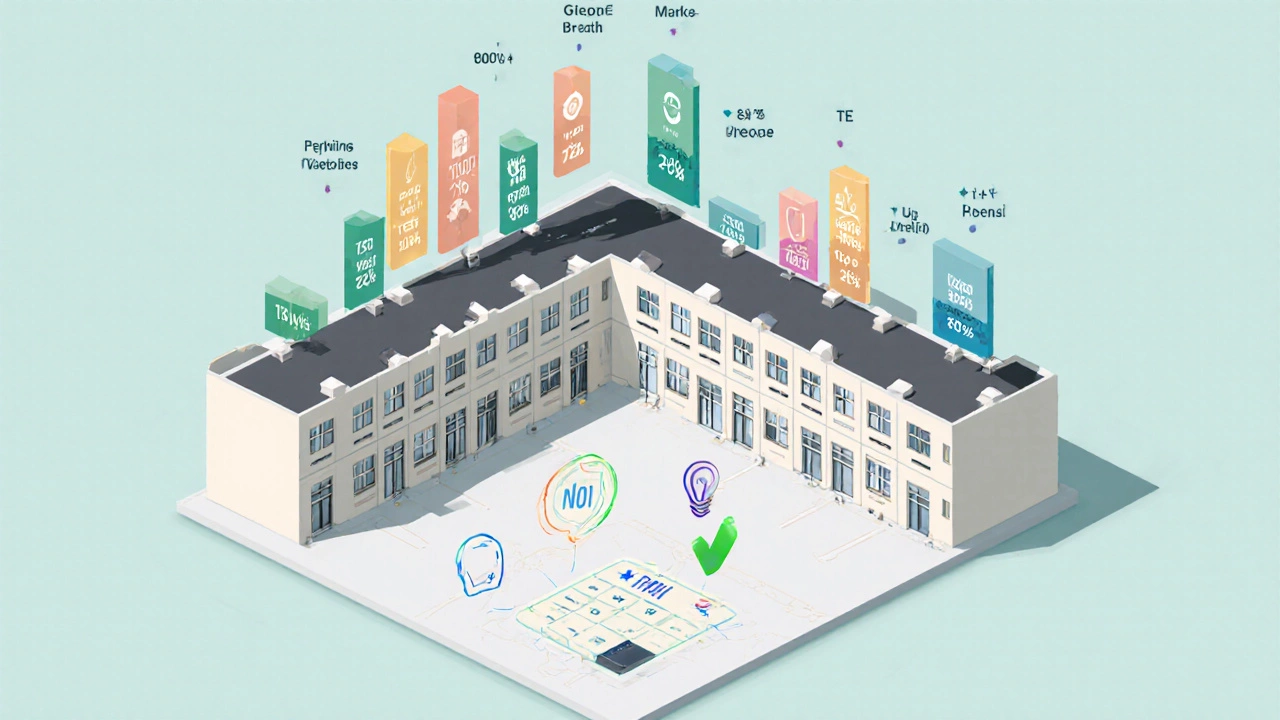What does NOI mean in business? Explained with real‑estate examples

Oct, 13 2025
NOI Calculator
Real Estate NOI Calculator
Calculate your property's Net Operating Income to understand its true operating performance before financing and taxes.
NOI is the buzzword that shows up in every real‑estate investment pitch, but many entrepreneurs still wonder what it really measures. Below you’ll get a plain‑English definition, step‑by‑step calculation, and real‑world tips on how to use it to size up a property.
Key Takeaways
- NOI stands for Net Operating Income - the profit a property generates before debt and taxes.
- It is calculated by subtracting operating expenses from gross rental income.
- Investors use NOI to estimate value, compare deals, and set the capitalization rate.
- NOI is not the same as cash flow; it ignores financing costs.
- A quick checklist can help you avoid common calculation errors.
What is Net Operating Income?
When you first encounter the term, think of it as the "bottom line" of a property’s day‑to‑day operations. It tells you how much money the building makes after you pay for everything that keeps it running, but before you pay any loan payments or taxes.
Net Operating Income is a financial metric that represents a property's revenue minus its operating expenses, excluding financing and tax costs.
How to Calculate NOI - A Step‑by‑Step Guide
- Determine Gross Rental Income is the total rent collected from tenants before any deductions. Include all lease payments, parking fees, and service charges.
- Subtract any vacancy allowance. A typical vacancy rate for a well‑located office building is 5% of gross rent.
- Add other income streams such as laundry, vending machines, or signage rentals.
- Calculate total Operating Expenses are the recurring costs needed to maintain and manage the property, such as maintenance, insurance, utilities, and property management fees. Do NOT include mortgage payments, interest, or capital expenditures.
- Apply the formula:
NOI = (Gross Rental Income - Vacancy Allowance + Other Income) - Operating Expenses
Example: A 20‑unit apartment complex collects $240,000 in annual rent. Assuming a 5% vacancy allowance ($12,000) and $10,000 in other income, the effective gross income is $238,000. If operating expenses total $90,000, the NOI equals $148,000.

Why NOI Matters for Property Valuation
Investors often use the Capitalization Rate is the ratio of a property's NOI to its purchase price, expressed as a percentage to estimate how much a property is worth.
The valuation formula is simple:
Property Value = NOI ÷ Capitalization Rate
If the same building in the example trades at an 8% cap rate, its market value would be $148,000 ÷ 0.08 = $1,850,000.
NOI vs. Cash Flow - Don’t Mix Them Up
Many newcomers think NOI equals cash flow, but they differ in two key ways:
- NOI excludes debt service (mortgage principal and interest). It reflects the property's operating performance alone.
- Cash Flow subtracts debt service from NOI and adds or subtracts tax effects.
To illustrate, suppose the $1,850,000 purchase is financed with a 70% loan at 5% interest. Annual debt service would be roughly $81,000. The cash flow after debt would be $148,000 - $81,000 = $67,000, a figure that can look very different from the NOI.
Cash Flow is the net amount of money left after paying all operating expenses and debt service, before taxes.
Common Pitfalls When Using NOI
- Leaving out hidden expenses. Things like replacement reserves, pest control, or legal fees can creep in later and shrink NOI.
- Using market rent instead of actual rent. Over‑estimating gross income inflates NOI and leads to poor purchase decisions.
- Mixing cap‑ex with operating expenses. Capital improvements are not part of NOI; they belong in a separate cash‑out analysis.
- Applying the wrong cap rate. Cap rates vary by asset class, location, and market conditions. Using a generic rate can misprice the property.

Real‑World Example: Converting NOI into Investment Decision
Imagine you're evaluating two office buildings in the same submarket.
| Metric | Building A | Building B |
|---|---|---|
| Purchase Price | $3,000,000 | $2,700,000 |
| Annual NOI | $240,000 | $210,000 |
| Cap Rate (market) | 8.0% | 7.5% |
| Implied Value | $3,000,000 | $2,800,000 |
| Debt Service (30‑yr @5%) | $180,000 | $162,000 |
| Cash Flow | $60,000 | $48,000 |
Even though Building B costs less, its lower cap rate means the market values it slightly higher than the asking price, suggesting a possible bargain. The NOI‑based analysis quickly highlights which property offers better returns before you even consider financing.
Quick Checklist Before You Rely on NOI
- Confirm actual rent roll - avoid using projected rents.
- Validate all operating expense categories and obtain recent utility bills.
- Apply a vacancy allowance that matches the submarket's historical trends.
- Use a cap rate specific to the property type and location, not a generic national figure.
- Separate capital expenditures from operating costs to keep NOI clean.
FAQ
What does NOI stand for?
NOI means Net Operating Income, the profit a property generates after operating expenses but before financing and taxes.
How is NOI different from cash flow?
NOI excludes debt service and tax expenses, while cash flow subtracts loan payments and may include tax considerations.
Can NOI be used for residential properties?
Yes. Landlords of single‑family homes, condos, or multifamily buildings calculate NOI the same way: rent minus operating costs.
What typical expenses are included in the NOI calculation?
Common items are property management fees, insurance, repairs, utilities (if landlord‑paid), taxes, and routine maintenance. Capital improvements are excluded.
How do I choose the right cap rate for my property?
Look at recent sales of comparable assets in the same market, consider the asset class (office, retail, multifamily), and factor in risk levels. Local broker reports often publish average cap rates.